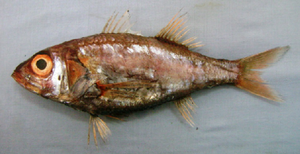Acropomatidae
| Acropomatidae | ||||||||||||
|---|---|---|---|---|---|---|---|---|---|---|---|---|

Acropoma japonicum , type species of the genus Acropoma |
||||||||||||
| Systematics | ||||||||||||
|
||||||||||||
| Scientific name | ||||||||||||
| Acropomatidae | ||||||||||||
| Gill , 1893 |
The Acropomatidae are a fish family from the group of perch relatives (Percomorphaceae). They live in the Atlantic , Pacific and Indian Oceans at depths of several hundred meters.
features
The fish are 10 to 40 centimeters long. They have two dorsal fins , which are supported by eight to nine hard rays and ten soft rays. The anal fin has three hard and seven to nine soft rays. All species of the Acropomatidae have 25 vertebrae and seven Branchiostegal rays . The species of the genus Acropoma have luminous organs in the abdominal region, which is why they are referred to in English as "lanternbellies" or "glowbellies". Her anus sits far ahead, the belly fin base, a feature that also in close comber Bullisichthys caribbaeus and the Kardinalbarsch ostorhinchus gularis occurs.
Systematics
The Acropomatidae family was introduced in 1893 by the American ichthyologist Theodore Nicholas Gill . It originally comprised ten genera and around 40 species . In this composition, however, the family was not monophyletic , but consisted of three clades with different positions in the phylogenetic tree. Thus forming Acropoma , the type genus of Acropomatidae family, along with Doederleinia the sister group of Scombropidae while z. B. the genera Malakichthys and Neoscombrops and their close relatives are the sister group of the wreck perch (Polyprionidae). To get back to monophyletic families, the families Malakichthyidae ( Jordan & Richardson, 1910 ) and Synagropidae ( Smith , 1961 ) were revalidated, so that only two genera remain in the family Acropomatidae, Acropoma with nine species and the monotypical genus Doederleinia . The three fish families can be distinguished by their fin formula .
- Acropoma genus
- Acropoma arafurensis Okamoto et al., 2019 .
- Acropoma argentistigma Okamoto & Ida, 2002 .
- Acropoma boholensis Yamanoue & Matsuura, 2002 .
- Acropoma hanedai Matsubara, 1953 .
- Acropoma heemstrai Okamoto & Golani, 2017 .
- Acropoma japonicum Günther , 1859 .
- Acropoma lacrima Okamoto & Golani, 2017 .
- Acropoma lecorneti Fourmanoir, 1988 .
- Acropoma leobergi Prokofiev, 2019 .
- Acropoma neglectum Okamoto & Golani, 2017 .
- Acropoma profundum Okamoto, 2014 .
- Genus Doederleinia
- Doederleinia berycoides (Hilgendorf, 1879) .
Fossil record
A fossil relative, Acropoma lepidotus, is known from the middle Eocene of the northern Italian Monte Bolca Formation, which arose from Tethys deposits .
Individual evidence
- ↑ Doederleinia berycoides on Fishbase.org (English)
- ↑ a b Ghedotti, MJ, Gruber, JN, Barton, RW, Davis, MP & Smith, WL (2018): Morphology and evolution of bioluminescent organs in the glowbellies (Percomorpha: Acropomatidae) with comments on the taxonomy and phylogeny of Acropomatiformes. Journal of Morphology, October 2018, doi: 10.1002 / jmor.20894
- ^ Joseph S. Nelson, Terry C. Grande, Mark VH Wilson: Fishes of the World. Wiley, Hoboken, New Jersey, 2016, ISBN 978-1118342336
- ↑ Ricardo Betancur-R, Edward O. Wiley, Gloria Arratia, Arturo Acero, Nicolas Bailly, Masaki Miya, Guillaume Lecointre and Guillermo Ortí: Phylogenetic classification of bony fishes . BMC Evolutionary Biology, BMC series - July 2017, DOI: 10.1186 / s12862-017-0958-3
- ^ Karl Albert Frickhinger: Fossil Atlas Fish , Mergus-Verlag, Melle, 1999, ISBN 3-88244-018-X
